Turkey stock is the foundation for incredibly flavorful soups, stews, gravies, and more When you make turkey stock at home, canning it preserves the flavor and lets you enjoy it for up to a year. But how long should you pressure can turkey stock to make sure it is safe and delicious?
Why Make and Can Turkey Stock at Home
Making and canning your own turkey stock has many benefits:
-
More flavor – Homemade turkey stock has a rich, meaty flavor that enhances any recipe. Commercial stocks often taste weak in comparison.
-
Food safety – When you make and can your own stock, you control the ingredients It won’t contain preservatives or additives
-
Cost savings – Homemade stock costs just pennies per jar. Store-bought stocks are far more expensive.
-
Reduce waste – Put turkey carcasses and scraps to good use. Why throw them out when they can make stock?
-
Convenience – Canned turkey stock is handy to have in your pantry. It’s pre-made and ready to use.
Step-By-Step Process for Making and Canning Turkey Stock
Follow these simple steps for delicious home-canned turkey stock:
-
Start with turkey bones. Use bones from a roasted turkey carcass or leftovers from cut-up turkey parts. Rinse briefly.
-
Add vegetables. Onion, carrots, celery, and garlic add flavor. Avoid strong-flavored veggies.
-
Season lightly. A little salt and pepper is all you need. Herbs like bay leaves are optional.
-
Cover with water. Add enough cold water to cover bones by 1-2 inches.
-
Simmer. Bring to a boil, then reduce heat. Simmer stock for 30-60 minutes.
-
Strain. Pour through a mesh strainer to remove bones and veggies.
-
Defat. Chill stock so fat rises and hardens. Skim off fat before canning.
-
Reheat. Heat stock back up to simmering before canning.
-
Fill jars. Ladle hot stock into clean pint or quart jars, leaving 1 inch headspace.
-
Wipe rims. Dampen a paper towel to clean jar rims so lids seal.
-
Apply lids. Place lids on jars and screw on bands fingertip tight.
-
Process. Pressure can for safety and shelf stability.
How Long to Pressure Can Turkey Stock
The USDA recommends pressure canning turkey stock in a dial or weighted gauge canner for:
- Pint jars – 20 minutes
- Quart jars – 25 minutes
These processing times are at sea level. At higher elevations above 1,000 feet, the processing time must be increased. Check a pressure canning altitude chart.
After processing, allow the canner to depressurize naturally. Wait 10 minutes before removing jars. Never force-cool the canner.
Tips for Successful Pressure Canning
Follow these tips for safely canned turkey stock with the best flavor:
-
Make sure your pressure canner is in good working order. Test the gauges annually.
-
Use new two-piece canning lids each time. Reuse rings. Check for defects.
-
Wipe rim of jars carefully before applying lids for a good seal.
-
Let pressure drop naturally. Don’t rush the depressurization.
-
Allow jars to seal and cool undisturbed for 12-24 hours.
-
After cooling, test seals. Lids should not flex up and down when center is pressed.
-
Label sealed jars with contents and date. Store in a cool, dark place.
-
Use within 1 year for best quality. Inspect before opening.
-
Discard any jars with rusty bands, leaks, bulging lids, or spoiled contents.
Enjoy Your Homemade Turkey Stock All Year Long
With the proper pressure canning processing time, home-canned turkey stock is shelf stable for up to a year. It brings concentrated turkey flavor to recipes anytime you need it. 20 minutes for pints and 25 minutes for quarts lets you safely preserve your turkey stock to enjoy for months to come.
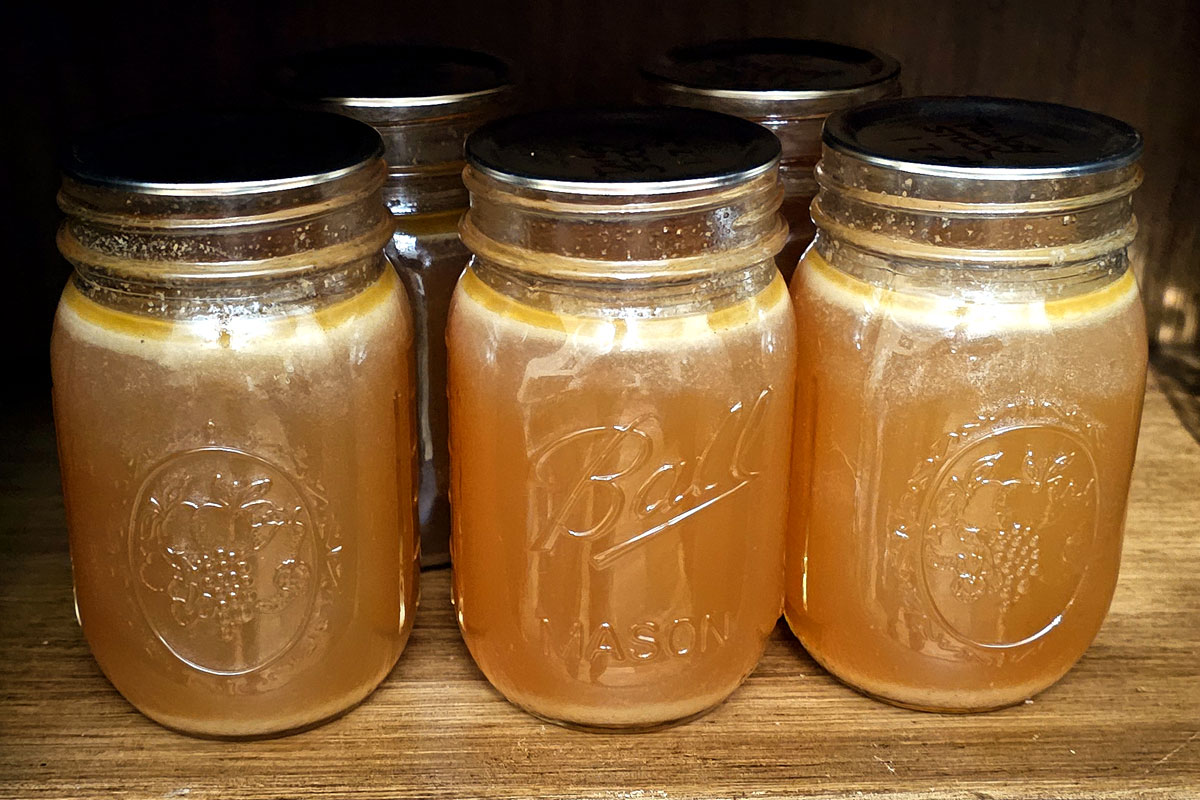
Canning turkey stock
- turkey (carcass and bones)
- water
- salt (optional)
- Take turkey carcass, clean all meat off it. (Tip: you can freeze meat in a baggie for adding to soup later.)
- (Optional: Some people like to roast the carcass for an hour or so at this point, for a darker, richer-tasting stock. )
- EITHER : Put carcass in pot with enough water to cover bones. Bring to a boil, simmer for 45 minutes. OR Put in pressure cooker. Add enough water to cover bones. Cook for 30 minutes on high pressure (13 to 15 lbs for most North Americans. See Notes.) A couple bay leaves tossed into either process make an inspired addition. Optionally, you can season with salt or a non-bitter, non-clouding salt sub (such as Herbamare), but, the plainer you leave the stock, the more flexible it will be when you go to use it.
- Strain into a large bowl or tub; have a second go at picking more of the loosened meat off it, add that to your bag of frozen meat, and put the stock in fridge over night.
- In the morning, scrape all the fat off the top; discard the fat and any added bay leaves.
- Reheat the stock to boiling in a pot or a microwave (mind the surge when removing from microwave.)
- Pour hot into half-litre (1 US pint) jars or 1 litre (US quart) jars.
- Leave 3 cm (1 inch) headspace.
- Wipe jar rims.
- Put lids on, put in pressure canner.
- Processing pressure: 10 lbs (69 kPa) weighted gauge, 11 lbs (76 kpa) dial gauge (adjust pressure for your altitude when over 300 metres / 1000 feet.)
- Processing time: half-litre (1 US pint) jars for 20 minutes. OR 1 litre (1 US quart) jars for 25 minutes.
See also if applicable: Dial Gauge Pressures.
How to pressure can.
When pressure canning, you must adjust the pressure for your altitude.
For salt substitute, we used Herbamare Sodium-Free as it is non-bitter and non-clouding in canning.
- You may see some people saying they simmer or boil their bones for stock for 5 or 6 hours. This is a waste of energy, as pressure cooking them for 30 minutes will yield the same results, with a fraction of the energy usage. Should you choose to boil, notice that the USDA suggests that 45 minutes is completely adequate. Any time beyond that has zero benefit to show for it.
- Laura Pazzaglia, author of Hip Pressure Cooking, says that for pressure cooking (note, not pressure canning), HIGH PRESSURE equals 13 to 15 lbs, or 90 to 100 kilopascals, or .9 to 1 bar. The pressure cooking time of 30 minutes for poultry stock also comes from the same excellent book, page 48. Note: if you are using an electric pressure cooker to make the stock in, such as an Instant Pot, she advises increasing the time to 33 to 35 minutes.
- Pressure cooking uses less energy and extracts more flavour and gelatin from the bones, resulting in a better quality stock.
- Above all, please do keep clear the difference between pressure cooking the stock to save energy and produce a superior stock, and then pressure canning it later to preserve it.
- When you first roast the turkey, deglaze the roasting pan with a small amount of boiling water from a kettle. Pour that into a tub and let sit overnight in fridge, skim fat off the next day. This will usually be a lovely jelly-like stock. Add that to the batch of stock you are making. If you do roast the turkey carcass, deglaze that roasting pan in a similar way, too.
- Roasting the turkey carcass can result in a wonderful deep rich flavour but also results in a quite dark stock, usually (photos show difference in stocks from roasted and unroasted carcasses.)
- Safety tip: After you have a plate of meat you have picked off a turkey carcass, always take a minute to feel carefully through that meat with your fingers, pressing it all, feeling for small bones. Be particularly mindful of treacherous flat bones from turkey legs.
- A bay leaf or two while you are boiling or pressure cooking the bones will elevate your stock.
- You could add a bit of salt or non-bitter, non-clouding salt sub per jar, but it could be argued that it’s just better to can it as is, then do flavour adjustments when you go to use it in something. Salt adds zero towards the safety of this recipe; it’s just a seasoning here. The safety is the pressure canning process.
United States Department of Agriculture (USDA). Complete guide to home canning. Agriculture information bulletin No. 539. 2015. Page 5 – 7.
- Added bay leaf for flavour;
- Added phase of overnight in fridge to skim fat off.
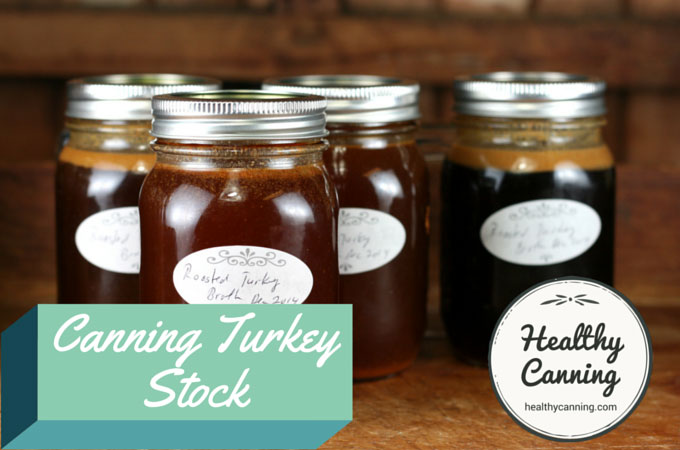
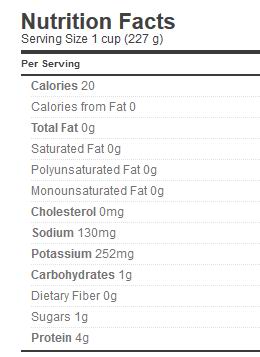
Per 250 ml ( 1 cup / 8 oz ): 20 calories
Weight Watchers PointsPlus®: 250 ml (1 cup / 8 oz ): 0 points; 500 ml ( 1 US pint / 2 cups/ 16 oz): 1 points.
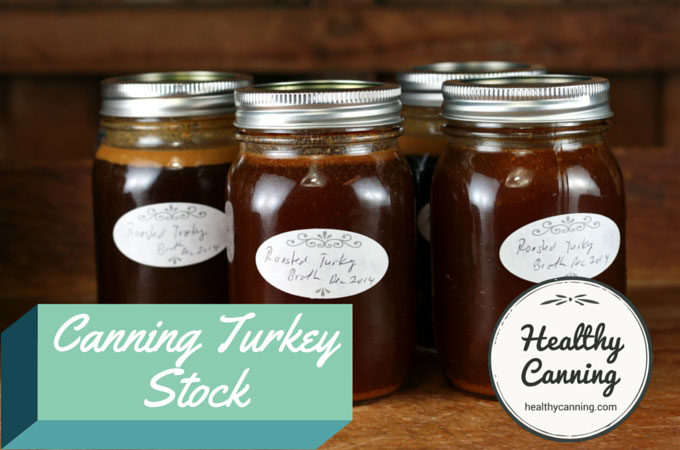
* Nutrition info provided by https://caloriecount.about.com
* PointsPlus™ calculated by healthycanning.com. Not endorsed by Weight Watchers® International, Inc, which is the owner of the PointsPlus® registered trademark.
* Herbamare ® is a registered trademark of the A. Vogel Corporation.
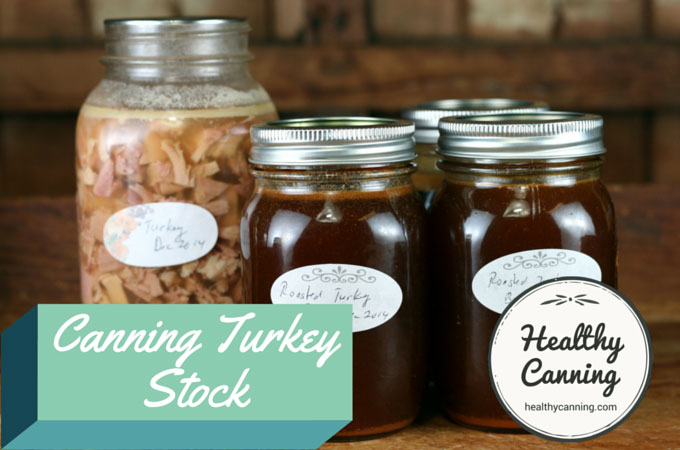
 HealthyCanning is a sub-project of cooksinfo.com. Read More…
HealthyCanning is a sub-project of cooksinfo.com. Read More…
Home Canning Turkey Broth With Linda’s Pantry
FAQ
How long do you pressure canning turkey stock?
How long is too long for turkey stock?
How do you know when turkey stock is done?
How long do you pressure canning a turkey?
How long does it take to make canned turkey stock?
See also: Canning Turkey, Canning Chicken Stock . Jar size choices: Either half-litre (1 US pint) OR 1 litre (1 US quart) Processing pressure: 10 lbs (69 kPa) weighted gauge, 11 lbs (76 kpa) dial gauge (adjust pressure for your altitude when over 300 metres / 1000 feet.) Processing time: Half-litres (pints) 20 minutes; litres (quarts) 25 minutes.
Can you freeze Turkey stock if you don’t have a pressure canner?
You will need to use a pressure canner to can turkey stock. There are no safe options for canning stock or broth in a boiling water canner. If you don’t have a pressure canner, you can freeze the stock in freezer containers or freezer bags instead. I have included tips below.
How long do you pressure can a stripe of beef?
Stock of any stripe gets pressure canned at 11 pounds of pressure for 20 (pints) or 25 minutes (quarts) in a gauged canner and at 10 pounds in a weighted canner. The National Center for Home Food Preservation has all the details and they can be found here.
Should you boil Turkey stock?
Whenever you make stock, try to avoid a vigorous boil, as it will make your stock cloudy. You really want to make sure that you make your stock within a day or two of the turkey’s roasting, as you’ll get the best flavor.
